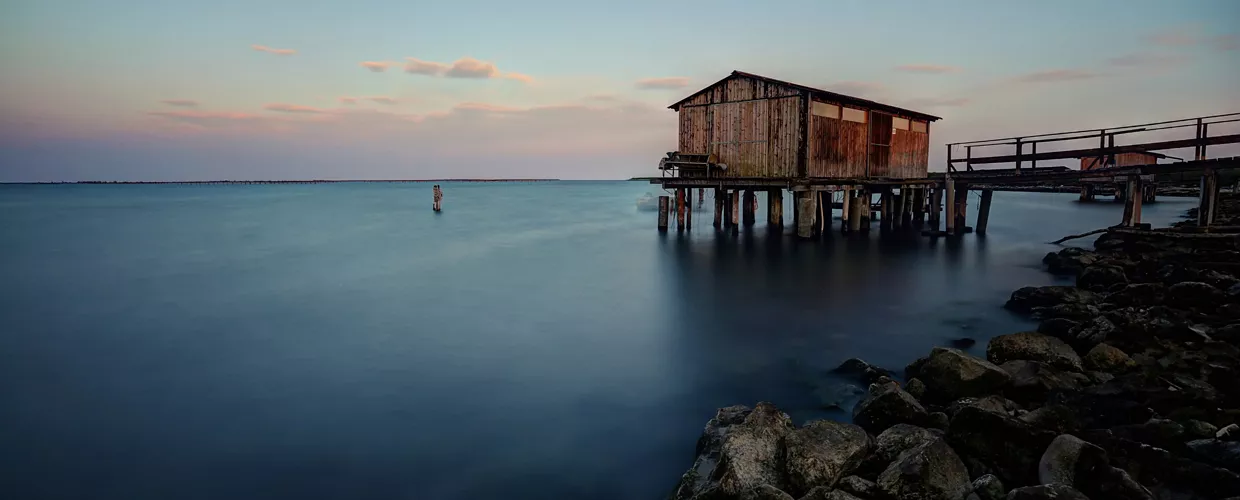

Overview
The Scardovari mussel, the black gold of the Delta
The bay, the fishermen's piles and a well-loved shellfish to be savoured slowly.
The Sacca di Scardovari
The Sacca di Scardovari is a deep inlet between the mouths of two branches of the Delta, the Po delle Tolle and the Po di Gnocca. A stretch of water of three thousand hectares, drawn between the rice fields and the last marshy areas, where the comings and goings of tidal waters combined with nutrient-rich freshwater flows create a unique brackish environment, which in recent years has proved ideal for shellfish breeding. The cozza (mussel), first and foremost, which in recent decades has ensured the fortune of this strip of Polesine: "the black gold of the Delta", according to a very apt slogan, the "Cozza di Scardovari PDO", although, according to the local dialect, it should be called "peòcio", or at least "mitilo", as per its scientific name, Mytilus galloprovincialis, but in the end, even in these parts they resigned themselves to calling it "cozza", as they do in Naples.
There are various mussel farming areas along the Italian coasts, each with its own special features. Scardovari mussels underpin their uniqueness with an environment far from urban or industrial sources of pollution and a constant water exchange due to both tide and river current. The naturally nutrient-rich fresh water prevails in the Sacca di Scardovari, and this allows the mussels to develop perfectly without the need for any special arrangements. All that is required is for the breeders to place the juveniles on supports that are suspended in the water and then follow their development over the months. Not forgetting that the local Fishermen's Consortium also deals with other seafood: verace clams (Tapes semidecussatus) and adriatic clams (Chamelea gallina); razor clams (Ensis directus); hard clams (Callista chione); sea truffles (Venus verrucosa); oysters (Crassostrea gigas).
On to the tasting!
The Sacca di Scardovari not only provides zero-kilometre raw ingredients, but also presents a variety of venues where you can immediately experience their quality. They go from the restaurant itself to the pile-dwelling that juts out from the embankment, having as their common denominator the entire local seafood scene: from the simplest dish, marinara style mussels and clams, as the traditional shellfish stew is called, to an imported speciality, spaghetti with clams, who have now acquired dual citizenship, Neapolitans by origin, Polesans by adoption. Also confirming this sort of Veneto-Campania twinning is the so-called pizza della Sacca, of course with mussels and clams. Memorable dishes include: mixed mussels au gratin, mussel risotto, clam stew, bigoli with clam ragù... Delicacies, which are presented again on the feast of Saints Peter and Paul, for the Fisherman's Festival in Scardovari.
The "Polesine dei sospiri", as this extreme strip of the province of Rovigo used to be called, so often at the mercy of ruinous floods, the most recent in 1951 and 1966. Major hydraulic works have revived the area, which has found its initial recovery in agriculture, with particular emphasis in the production of rice, and later fortune in the farming of bivalve molluscs, mussels and clams first and foremost. The Consortium was created in 1976, bringing together all 14 fishermen's co-operatives in the area in a first-class business venture. The 1980s saw a market breakthrough that after thirty years can be said to have peaked in 2013 with EU recognition of the PDO, or Protected Designation of Origin for the "Cozza di Scardovari", alongside a true French celebrity, the "Moule de la Baie du Mont-Saint-Michel" AOP.
Today, the Sacca di Scardovari production area involves 1,500 fishermen and the rather astonishing thing is that half of them are women. Which can be explained in the more recent history of business in Veneto. In fact, there were years when Polesine represented a kind of new frontier of the textile industry, mostly benefitting female labour. After that period, it was shellfish farming that resurrected the territory's fortunes, leading it over the years to an unprecedented prosperity.
Strada Provinciale 38 (Isola della Donzella), 45018, 45018 Porto Tolle RO, Italia